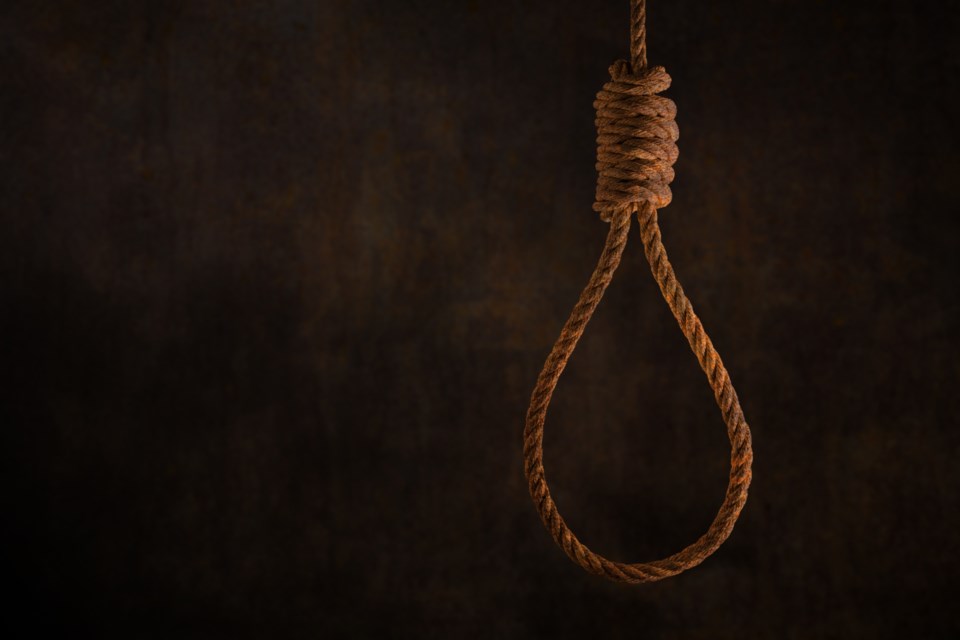The last person executed at Sudbury Jail in 1956 is buried in an unmarked grave at Park Lawn Cemetery in the city’s west end.
Robert Bruce Ducsharm (most instances use this spelling, but at least one newspaper account, in the Calgary Herald, has the spelling as “Ducharme”) died a lonely death. His family did not visit before he was hanged for the murder of teacher Steve Klapouschak.
The hanging took place June 15 just after midnight. No one claimed his body.
The late Sudbury historian William E. McLeod wrote a book, Murder in the Schoolhouse, Sudbury, Ontario’s Last Hanging in 2007, about the case.
Klapouschak, 21, who was originally from Timmins, taught in a one-room school in Dalton, a small village west of Chapleau. He lived in rooms attached to the school.
He developed a romantic relationship with Ducsharm, a 23-year-old CPR maintenance worker, and they soon moved in together. Shortly afterwards, in early December 1954, Klapouschak and Ducsharm quarrelled. The argument may have been about a visit from Klapouschak's friend, John "Red" Naegel.
According to McLeod, in the early morning of Saturday, Dec. 4, Klapouschak was working at his desk in the school. Ducsharm used Klapouschak's .22 calibre rifle to shoot him through one of the school's windows and then hid the body under some boards beside the building.
He quickly took the train out of town and headed to his parents' home in Hamilton.
The next day, Naegel arrived in Dalton and called the police to report his friend was missing. Klapouschak's body was discovered a week later. Children were playing near the school when the body was found.
"One (child) was so traumatized that he never went back to school and never did learn to read and write. No classes were ever held in the school building again and it was demolished," wrote McLeod.
Some villagers thought Naegel might be the murderer, but there is no evidence in the police files that he was considered a suspect. Naegel was killed in an accident at Renabie Mine in January 1955.
Ducsharm was a suspect from the beginning and he was arrested in Hamilton on Dec. 11, 1954, the same day the Klapouschak’s body was discovered. He went on trial May 16, 1955, in Sudbury.
Four days later, the jury took four hours to return a verdict of guilty. Ducsharm was sentenced to death.
The defence lawyer filed an appeal, which was heard in Toronto. A new trial was ordered by the Ontario Court of Appeal because of prosecutorial and judicial errors.
A new judge and a new Crown attorney were sent from Toronto to Sudbury to preside at the new trial, which started Feb. 21, 1956.
The case went to the jury on March 1 and after five hours of deliberation, another guilty verdict was returned. A second appeal was denied.
The murder trial had been followed closely in Sudbury. A significant crowd gathered outside the jail after midnight June 15, 1956, when Ducsharm was executed.
The daily newspaper reported, "more than 70 people crowding the sidewalk, and 16 cars, most full of teenaged girls, were parked on both sides of the street near the jail, their occupants' eyes darting across the broad lawn to the well-lighted jail."
There were five other hangings at Sudbury Jail.
- Wasyl Daybuk, 34, a Copper Cliff labourer was convicted for the murder of Mary Korenluk, 21, in the spring of 1916. Korenluk was bludgeoned with an axe outside a King Street boarding house.
- Peter Myhal hanged Dec. 12, 1929, for the downtown Sudbury shooting death of his common-law wife, Rose Karas.
- Tom Pornomarenko, 47, was executed Jan. 22, 1938, for killing Sudbury policeman Fred Davidson. The hanging was the first one in the new jail building.
- Alpha "Eddie" Proulx, 26, lost his life Jan. 9, 1945, for the beating death of Joseph Dennie of Capreol.
- Adelard Latour, 50, a bush worker, hanged May 22, 1951, for the stabbing death of Cecile Rainville, 23, in her Van Horne Street basement apartment.
The death penalty was abolished in Canada in 1976. Ronald Turpin and Arthur Lucas, the last two people to hang in Canada, were executed for murder at Don Jail in Toronto in 1962.
The death penalty was permitted until 1998 under the National Defence Act for members of the military found guilty of cowardice, desertion, unlawful surrender, or spying for the enemy.
Vicki Gilhula is a freelance writer in Sudbury. Then & Now is made possible by our Community Leaders Program.
Sources
William E. McLeod, Murder in the Schoolhouse, Sudbury, Ontario’s Last Hanging, 2007
The Sudbury Star, Michael Whitehouse, "50 years ago, it was an eye for an eye," Nov. 18, 2001



